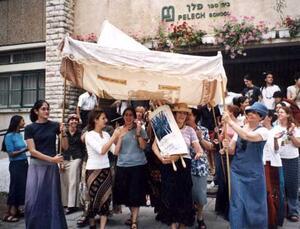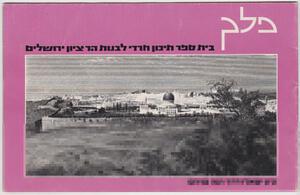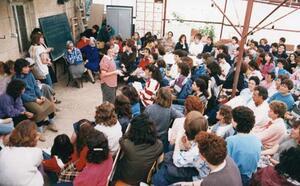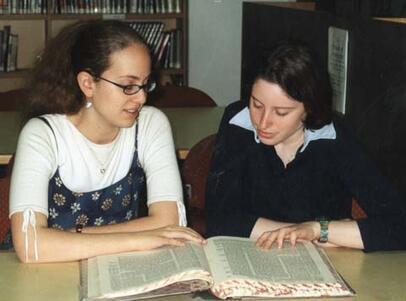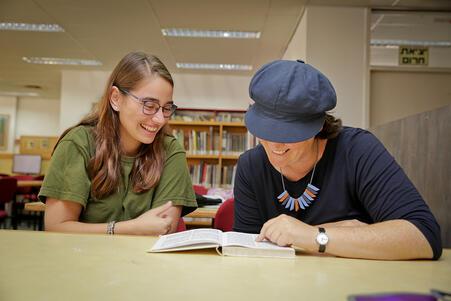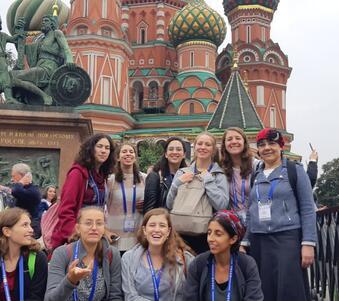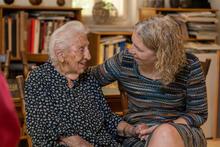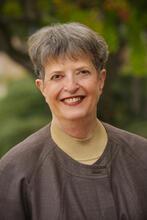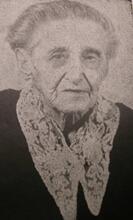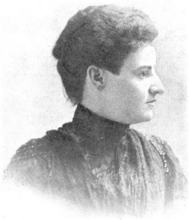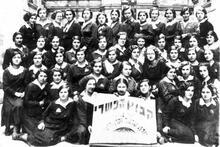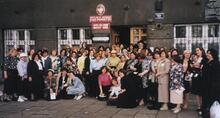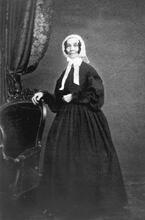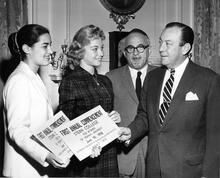Pelech Religious Experimental High School for Girls, Jerusalem
For over half a century, Pelech has been a pioneer in teaching Talmud to its students, as well as unique programs such as women’s studies, Yiddish, the arts, theater, and the sciences at a high level. Pelech specializes in developing interdisciplinary programs in the humanities and combining Torah studies with art. Students are educated through a love of knowledge and learning, to develop intellectual habits of mind and skills, as well as curiosity to widen their horizons. Pelech graduates are knowledgeable young women who are confident in their ability to analyze social structures and take a stand as leaders in their communities, youth movements, and various volunteer programs.
The history of the Pelech School can be divided into segments, based on the inspiring woman leading it as principals: its establishment by Rabbi Shalom and Penina Rosenbluth and the initial phase (1963–1975), its formative years with principal Alice Shalvi (1975–1990), and consolidation and ongoing innovation with principal Shira Breuer (1990–2016). Rachel Tzur and Sophie Pfeffer have incorporated their own Pelech education and adapted it to the changing times.
Establishment of the Pelech School
The very first Pelech was set up in the clubhouse of the Bnei Akiva youth movement in Pardes Hannah in 1963. Rabbi Shalom Rosenbluth (1917–2003) and his wife Penina (b. December 12, 1926), two highly educated and cultured teachers, were seeking to provide an educational alternative for their daughter. When they moved to Jerusalem three years later, Pelech moved with them, relocated to a children’s nursery in the Bayit va-Gan neighborhood of Jerusalem. The first Pelech was an ultra-orthodox (Haredi) school, seeking to provide a broader learning alternative to the Bais Ya’akov network.
From its outset, the Pelech curriculum included Lit. "teaching," "study," or "learning." A compilation of the commentary and discussions of the amora'im on the Mishnah. When not specified, "Talmud" refers to the Babylonian Talmud.Talmud (Gemara) as a compulsory subject. This was a revolutionary step within the Israeli religious educational system; Talmud was off limits to ultra-orthodox Haredi girls and traditionally reserved for boys within the state religious system. “Reb Sholom” and Penina invested all their energies and resources into the school, introducing a variety of subjects and teaching curriculum previously unknown in the religious school system.
Some time after the Six Day War, Reb Sholom managed to persuade the Ministry of Religious Affairs to rent Pelech an abandoned building on Mount Zion. With a student population of just fifty girls in four grades, there was no need for full-time staff. The Rosenbluths themselves were more than accomplished teachers. Reb Sholom himself taught Talmud, mathematics, and physics, while Penina taught English. Other teachers taught several classes each week, often as a personal favor to the Rosenbluths. The staff comprised an illustrious group of up-and-coming academics who went on to become renowned university professors and community leaders, including Rabbi Yehuda Amital, Rabbi Mordechai Breuer, Professor Andre Neher, and Dr. Hananel Mack.
Within a short time, Pelech was causing controversy and was put under Ban; excommunication (generally applied by rabbinic authorities for disciplinary purposes).herem by the Haredim, the very community it had sought to enlighten. It did, however, appeal to the Modern Orthodox community in Jerusalem, who had long felt the need for a less parochial, broad-based approach to girls’ education. Families headed by well-known academics, community leaders, and members of the free professions started to send their daughters to Pelech. Alice Shalvi’s involvement with Pelech began as a parent seeking an alternative educational environment for the oldest of her three daughters.
The Yom Kippur War, which broke out in October 1973 and dragged on for almost a year, marked the first of several crises for the fledgling school. Most of the male teachers were drafted, leaving Reb Sholom to teach nearly all the classes. The terrorist attack on a school in Ma’alot in 1974 shocked the parent body of Pelech into awareness of the vulnerability of the girls in a remote location. Added to this was the ongoing physical and financial drain on the private resources of the Rosenbluths. Pelech had not yet received accreditation from the Ministry of Education. Those parents who could afford it paid fees, but the remaining expenses, including the renovation of the dilapidated building, had been covered by the Ronenbluths personally. In an effort to attract more students, Pelech had, at one time, provided dormitory facilities and a summer school. Penina Rosenbluth had personally borne the physical strain of running these facilities.
By the mid-1970s, Pelech was educating a very different population from the one the Rosenbluths had planned. In the spring of 1975, after much effort, adversity, and disappointment, the Rosenbluths sadly declared their intention of closing the school at the end of that academic year.
Formative Years Under Alice Shalvi
It was at this point that parents who had come to appreciate the school’s philosophy and profound difference, in both principle and practice, from other religious high schools for girls determined to work together to ensure its future. Alice Shalvi volunteered her services for a limited period with the aim of taking the administrative load off the Rosenbluths and enabling them to continue their educational work. Much to her surprise, Shalvi found herself being introduced as the school’s new principal. It was to take over her life for the next fifteen years.
In 1975, Pelech moved to highly unsuitable premises in an apartment building in Bayit va-Gan. In a crowded four-room apartment, Alice Shalvi set about hiring staff—young people, mainly women—to join her in an educational adventure that would set a new path in girls’ high school education. Physically, conditions were worse than ever, but educationally, her timing could not have been better. David Pur, the founding principal of the innovative school at A voluntary collective community, mainly agricultural, in which there is no private wealth and which is responsible for all the needs of its members and their families.kibbutz Givat Brenner, had just been appointed head of high school education at the Ministry of Education. His educational reform granted greater autonomy to schools that wished to implement innovative courses and methods. Alice Shalvi was not trained as a high school teacher; she was a Hebrew University lecturer in English literature, specializing in Shakespeare. But her educational vision, creative curricula, and frequently outrageous experiments were just what the Ministry was looking for. After three years of hard work, Pelech was accredited as one of the (then) only two officially recognized “experimental” high schools.
In 1976, the school was on the move once again as the municipality inexplicably decided that it required the completely inappropriate premises occupied by Pelech for a new secular primary school that the authorities wanted to establish in the predominantly Orthodox neighborhood. Pelech was allocated an abandoned three-story house in the then-dubious (later gentrified) neighborhood of Bak’ah. In return for Pelech’s renovating the building, installing central heating, and planting a garden, the municipality waived the rent payments. An outhouse was converted to an all-purpose science laboratory and a toilet was converted into a staff room. Thus began the years of innovation and excellence for which the school rapidly became renowned.
In determining the educational philosophy of Pelech, Alice Shalvi first relied on her personal experience as a mother and her feminist conviction that no area of knowledge should be inaccessible to girls and women on grounds of sex. She was also inspired by the work of several educators, including David Pur and Daniel and Hannah Greenberg, who had founded the Sudbury Valley School near Boston. This child-centered and student-governed school provided the model for the democratic institutions of government that were initiated at Pelech.
Some of the most important achievements from this period include the following:
- The Student Council as a democratic institution that involves students and teachers in the decision-making process of the school.
- New modes of evaluation, including “take-home examinations” and “library examinations” that test the student’s research abilities and personal integrity.
- Personal tutors who reinforce the work of the home room teachers by meeting regularly with each student to monitor their educational, social and emotional progress.
- Introduction of Environmental Studies, Yiddish, and Theater.
- An interdisciplinary Humanities Course combining sociopolitical and economic history studies (including Jewish history) with the study of literature, art, music and philosophy.
- “Israeli Society”: a four-year course replacing the civics course required by the Ministry of Education with study of Israel’s ethnic composition and institutions of government and their interface with Jewish tradition.
-
Family Studies: including units on women’s health, choice of a life partner, family planning, child psychology, and the parental role in child development. The The legal corpus of Jewish laws and observances as prescribed in the Torah and interpreted by rabbinic authorities, beginning with those of the Mishnah and Talmud.halakhic aspects were integrated at every stage to include dietary laws, family purity (taharat ha-mishpahah) and rulings on contraception.
-
Conflict and Conflict Resolution: developed after the outbreak of the first Intifada in 1988 by deputy principal Aryeh Geiger, together with philosophy teacher Shulamith Levy, herself a Pelech graduate, to provide a multi-faceted approach to the divisions within Israeli society, comprising traditional moral Jewish principles and modern methods of social dynamics and psychotherapy. The program included meetings with students from different sectors of Israeli society, which was unusual at that time, including students from secular schools and Palestinian Arab schools in east Jerusalem. It is no longer in the Pelech curriculum.
Pelech thrived in an atmosphere of creativity, innovation and social commitment. The family atmosphere within the school and open channels of communication between teachers and students were legendary. It became difficult to get accepted, with three girls competing for every available place. In 1993 (after the Shalvi period but based primarily on the work carried out during her years), Pelech received the Israel Education Prize for its pioneering educational work. The majority of classes still took place in the cramped, though moderately renovated, house on Gideon Street, but happily, thanks to Shalvi’s tireless fundraising activities, the school was now solvent enough to invest in purpose-built science laboratories and a beautiful Houses of study (of Torah)bet midrash in a nearby historically protected building.
Controversy has played its role in the history of Pelech. The school’s insistence on encouraging its graduates to serve in certain units of the Israel Defense Forces set a new precedent for religious girls in Israel. An uphill battle with the Ministry of Education to receive recognition for Pelech experimental programs at bagrut (matriculation) level was ultimately successful and provided a precedent that benefited other schools. Not all adversity was settled so easily, and the controversy concerning the perceived clash between Alice Shalvi’s political activities—both with Palestinian women and as head of a feminist organization, the Israel Women’s Network—and her tenure as principal of a religious high school finally came to a head in 1990, precipitating her resignation.
Ongoing Innovation
After several months of uncertainty regarding Alice Shalvi’s successor, the Board of Governors appointed Shira Breuer as the new principal of Pelech. Breuer was a young, accomplished history teacher who had worked at Pelech since 1986. American-born and Israeli-educated, Breuer, like the previous principals of Pelech, imprinted her own style on the ongoing history of Pelech.
In 1998 the Jerusalem Municipality granted Pelech the use of a renovated school building, previously the Nitzanim School, adjacent to Pelech’s Beit Midrash building. The improved facilities—including a purpose-designed library, an auditorium, dance studio, art room, computer laboratory, and appropriate staff accommodation—facilitated greater teaching options and a more relaxed atmosphere.
In 2011, Pelech opened a Junior High School and added grades seven and eight. Rachel Tzur, a Pelech graduate who had returned as a teacher, educator, and vice principal, founded the junior high and served as principal. Tzur holds a BA and MA in education and art history from the Hebrew University.
In 2015, Sophie Pfeffer, a Pelech graduate and staff member for many years, took over as Principal of both the junior high and the high school. Pfeffer holds degrees in bible studies and art history from the Hebrew University and was a fellow at the Mandel Leadership Institute and a graduate of the Avney Rosha training program for principals. She has taught at Midreshet Lindenbaum and Matan, as well as many years at Pelech.
In 2020, an extensive renovation took place, which allowed the junior high to join the high school in the same building and will allow for future expansion. The renovations included an enlarged and upgraded library, to include a Beit Midrash and learning center as well as an auditorium and Beit Knesset (synagogue).
Many of the original programs have continued at the school, adapted to changing needs. The personal counselor system, the student council, and the honor system remain pillars of the Pelech educational philosophy. Several programs have been expanded. The interdisciplinary humanities program now includes an expressive, experiential unit combining bible and art. This program has enhanced and been accepted into the Ministry of Education’s matriculation program in Tanakh.
The interdisciplinary science curriculum includes an innovative unit combining physics and computer science. In 2017, Pelech physics majors became the first all-girl delegation to attend a week-long seminar at the labs and particle accelerators in CERN, Switzerland. The girls prepared very seriously for this visit and experienced first-hand the work and research of leading international scientists. In 2019, Pelech students represented Jerusalem in the 4th International Olympiad of Metropolises, in Moscow, returning with a bronze medal in the math competition and group achievements in other science competitions. Once again, Pelech students were the only all-female team, as well as being Jewish and religious; they provided a unique collaboration with international students and a memorable experience.
Another flagship program is Pelech's pioneering excellence program in the Humanities, established and accredited by the Ministry of Education in 2018. The students learn canonical texts with their peers and develop critical thinking and writing skills while receiving continuous feedback from professional teachers. The Pelech program is inspired by the Great Books core curriculum and adapted to create a feminist canon for young women. The Humanities teachers helped develop similar programs in schools around the country, inspired by Pelech’s curriculum.
Other additions to the teaching program include:
-
Mathematics and Graphic Computers: a national school experiment first introduced at Pelech.
-
Feminism and Philosophy: an interdisciplinary program combining traditional sources and feminist texts defining the identity of the Jewish woman.
-
“Tekufot” (semesters): an intensive, subject-based reorganization of the school schedule based on the concept of the university semester to increase the level of study and research. This is a pioneering methodology that has redefined Pelech’s experimental status with the Ministry of Education.
-
Special Education Class: one group is accepted to Pelech every six years. Development of innovative academic program to bagrut (matriculation) level and full participation and integration in the informal education program.
-
Option of an additional year, following graduation, to improve bagrut grades and prepare for army and national service.
Pelech’s religious identity has matured, reflecting changes in the Modern Orthodox community. Twelfth-grade students study Daf Yomi (literally: a daily page of Talmud) and have increased the tractates of Talmud they study—not for grades, but because they love it. Kri’at ha-Torah (Torah reading) takes place voluntarily and without a blessing every Moday and Thursday as well as on Rosh Hodesh (first day of the new month). Every year on Holiday held on the 14th day of the Hebrew month of Adar (on the 15th day in Jerusalem) to commemorate the deliverance of the Jewish people in the Persian empire from a plot to eradicate them.Purim, students read the Megillah (the Book of Esther) at the school. In 2004, a women’s Hakhnasat Sefer Torah (inauguration of a Torah scroll) took place at the school, with the participation of hundreds.
Pelech was one of the first Orthodox schools in Israel to choose a female rabbinical authority for its students. Pioneering this idea in 2010, the school hosted a seminar dedicated to the question of the appropriate name for a Jewish woman scholar. This seminar was attended by many Israeli religious feminists to discuss a burning topic in Israeli society.
Also in 2010, Pelech established Dvash, a school Beit Midrash founded by the then school Rabbi, Hanna Godinger (Dreifuss), and run since 2018 by Rabanit Ayelet Segal, a Pelech graduate herself. Dvash is a voluntary, after-school forum for Tora L’shma, studying Torah for the sake of learning without the incentive of grades or exams. Participating students study with a wide range of spiritual and religious leaders, learning together Halacha, chasidut, Talmud, and more. Dvash allows students to create individual connections to their spiritual and religious world. With the Beit Midrash open to students of all grades, girls found new Hevruta study partners.
The volunteerism unit has been expanded, and every student from grade seven through twelve volunteers as part of the school social justice program. The program encourages awareness and individual responsibility. Several students have initiated projects in the local community that became national projects covered by the media.
Expansion
Although many schools have introduced Pelech methods into their teaching program, the opening of a second Pelech School in September 2000 in Kiryat Ekron, Rehovot, was a major landmark. The school was the initiative of a group of parents who were familiar with the Pelech model as an alternative to their local religious state schools. Shira Breuer and the Pelech staff were deeply involved in the establishment of the school, and the two schools remain in close contact educationally. As with the original Pelech, Pelech Kiryat Ekron has faced controversy and criticism from the local religious community. At one time it was unclear if it would survive. However, from its modest start with two classes of seventh- and eighth-graders, it is now a fully fledged high school based on the Pelech educational philosophy and implementing Pelech programs.
Subsequently, Pelech schools opened in Tel Aviv and Zichron Yaakov, as well as a Pelech Boys’ school in Jerusalem. Each school received guidance and assistance in continuing the Pelech values and adapting them to their own communities.
Pelech was and still is recognized as an educational model, and educators from many different schools in Israel and abroad have introduced its methods. A number of educators and graduates from Pelech have become school principals. Over two thousand graduates have taken the Pelech experience with them, fulfilling Pelech’s primary aim: to instill the values of religious commitment and broad culture, to further religious women’s leadership, and to prepare students to take their place as informed, committed, active members of society. A mini-survey of Pelech graduates in 1999 showed a significant number of graduates involved in the caring professions: education, social work, and psychology. A number of graduates have returned to teach at Pelech.
Now, Talmud learning for women is a recognized fact, and Pelech graduates have been conspicuously involved in the establishment and ongoing activities of the Batei Midrash (learning groups, particularly of Talmud) that have proliferated in the Modern Orthodox community. They have been prominent in the establishment of alternative minyanim (prayer groups) and in lobbying for the improved status of women in issues of halakhah (Jewish Law).
Pelech graduates also take leading roles in promoting STEM education (science, technology, engineering, and mathematics) for young women, have founded social justice initiatives, and are part of many educational programs.
It may be said that the improved status of women within the Modern Orthodox community over the last few decades has enabled Pelech to establish a new identity. The converse has also been suggested: that Pelech has contributed to the improved status of religious women.
Shalvi, Alice. “‘Women’s Wisdom Has Built Its Home’—A Highly Personal Account of the Pelech Experiment.” In Studies in Jewish Education, vol. 7, edited by Walter Ackerman. Jerusalem: 1995.

